Growing cannabis indoors with a carbon filter

It's no secret—growing weed smells. Here, we look at carbon filters, simple creations that can absorb that pungent scent and keep your grow odourless and secret. Find out how they work, and how to make your own carbon filter at home!
Contents:
- What does a carbon filter do in your grow room?
- How do carbon filters work in a cannabis grow room?
- Where do you place carbon filters in your grow room?
- How to make a carbon filter for your cannabis grow room
- Can I clean a carbon filter in my grow room?
- How often should you change a cannabis carbon filter?
- Can you recycle carbon filters?
- Do you need a carbon filter to grow cannabis indoors?
It’s no secret that weed smells. In fact, those pungent terpenes are one of the many reasons people love it so much. However, when growing many plants in a small space, the concentrated mass of terpenes can create an overwhelming smell, and one that can put illicit growers at considerable risk.
In this article, we explain what carbon filters are, and show you how to build your own at home.
What does a carbon filter do in your grow room?
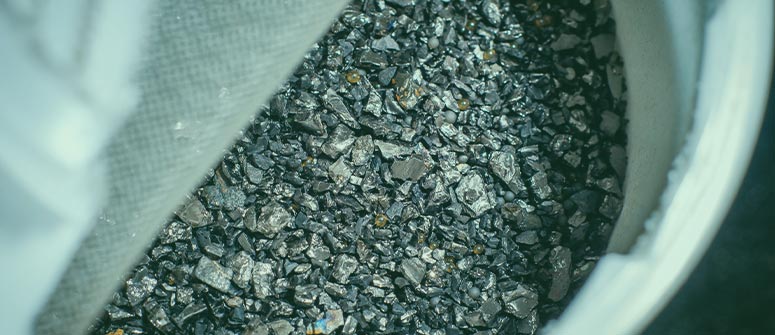
Carbon filters are mainly used in cannabis grow rooms to stop the smell of the crop from reaching the wider world. They are attached to the ventilation system, and can be very useful for keeping your operation stealthy and stopping your house from stinking of weed for a few months. Both worthy pursuits!
Carbon filters come in two forms: granular and block.
- Granular carbon filters are smaller and cheaper, and are well-suited to small, casual home grows. While they will need to be replaced eventually, they should last for several harvests before this is necessary. These are the best choice for budget grows and grow tents.
- Block carbon filters are larger and have replaceable filters. They are generally better at filtering, especially for large spaces. However, they are more expensive than granular filters and will probably be overkill for small home grows.
Both types tend to be cylindrical, and are sometimes housed inside a cuboid box. They will always have two fans, one to draw air in, and the other to pump air out. There are some claims that these filters can also help to remove other contaminants from the air—such as mould—but these assertions are not proven.
How do carbon filters work in a cannabis grow room?
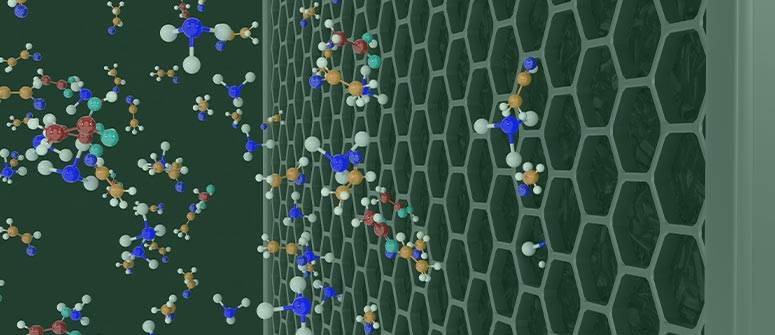
Carbon filters use activated charcoal to absorb molecules—in this case, airborne terpenes. This same activated charcoal is used in commercial sploofs. As mentioned, carbon filters use two fans. The first pulls air into the filter, where terpenes become trapped. The second fan blows the air out, hopefully terpene-free!
Activated charcoal has an incredibly porous surface, meaning it is highly absorbent. One gram of activated charcoal has a surface area of around 3,000m². Flattened out, this is about the same size as just under half a football pitch. Given that, there’s plenty of space for terpenes to get caught up as they pass through the filter.
Where do you place carbon filters in your grow room?
You want to place the carbon filter as high up in the grow room or grow tent as possible, in the middle. That way, the inlet fan will draw the air up and pass it through the filter.
You also need to feed the ducting out of the tent/room so that the outlet can release the odourless air somewhere. This can be fed through a hole in the tent, a window, or a hole in a wall.
How to make a carbon filter for your cannabis grow room
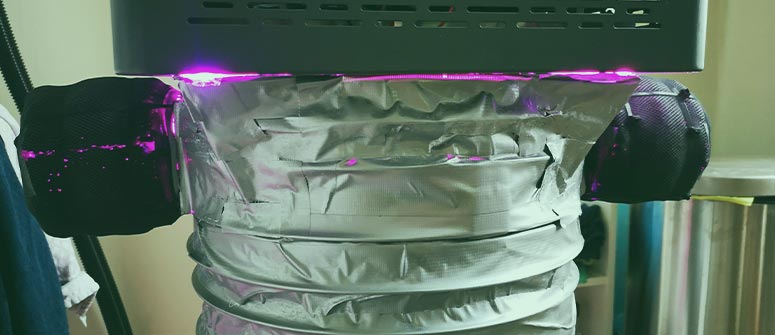
For many, buying a ready-made carbon filter will probably be the easiest option. But, for some, it might be tempting to build your own. Whether from a love of building things, a tight budget, or both, building a DIY carbon filter can be a good project. And while it sounds as though it could be pretty tough, it’s actually not too challenging.
What do you need?
Most of the materials are easily accessible, and you can probably source all of them from a hardware store.
- Roll of aluminium screen or chicken wire
- PVC cleanout cap and PVC adaptor of the same diameter
- Dryer vent hose
- Roll of duct tape
- Role of quilt batting
- Laundry basket (ideally one with a lid)
- Activated carbon/charcoal
Making a carbon filter: step by step
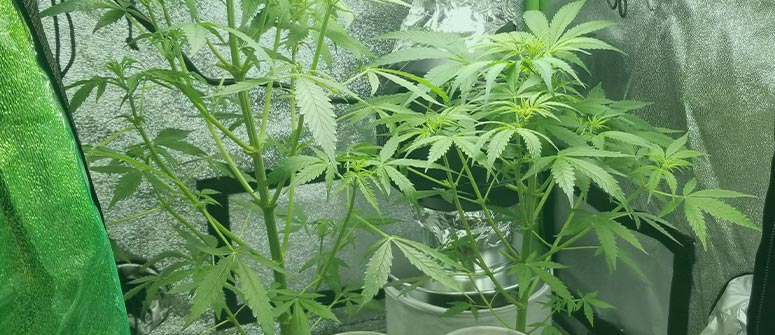
- Use the aluminium screen or chicken wire to create a cylinder with the same diameter as the PVC cap.
- Insert the cap into one end, and secure using duct tape. This is better than using glue, as it means that you can change the carbon.
- Place the tube inside of the basket, open end upward.
- Trim it down until it is the same height as the rim of the basket.
- Remove from the basket and insert the PVC adapter into the open end. Secure with duct tape.
- Fold the quilt batting over itself for double thickness. Wrap it around the cylinder. Secure with duct tape.
- Replace the tube in the basket with the PVC adapter facing upward.
- Add more batting until there is a 3cm gap between the cylinder and the walls of the basket.
- Fill the gap with activated carbon.
- Cover the top of the basket with a double layer of batting.
- Cut a hole for the PVC adapter.
- Attach one end of the dryer hose to the cleanout cap, and attach the other end to your exhaust fan.
Can I clean a carbon filter in my grow room?
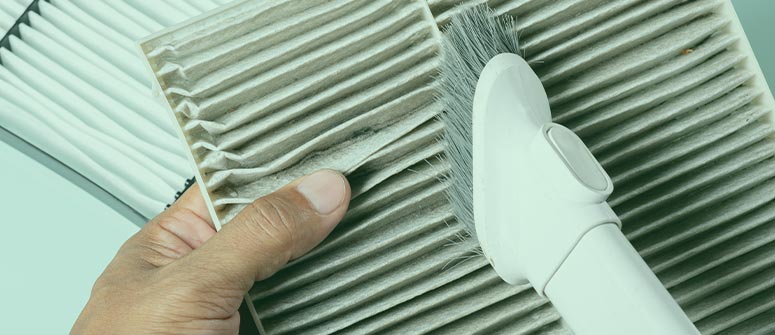
To ensure that a carbon filter draws properly, the pre-filter (the fabric part) needs to remain clean and porous. This means that, occasionally, it should be washed with water and detergent. Depending on the filter, it might be easy to remove the fabric, or difficult. Cleaning all parts of a grow space is necessary from time to time.
Note that you cannot clean the activated charcoal. Once it stops working, that’s it; it needs to be replaced.
How often should you change a cannabis carbon filter?
On average, a carbon filter should last for around two years before it becomes clogged. However, this depends on usage. If you hardly use it, it will last much longer. But if you use it regularly, you can expect it to last around this long.
Many filters, including the DIY one described above, have replaceable charcoal, which means that you can use most of the materials again and again, and just replace the actual carbon. Combine this with washing the pre-filter, and you’ve got a long-lasting piece of kit.
Can you recycle carbon filters?
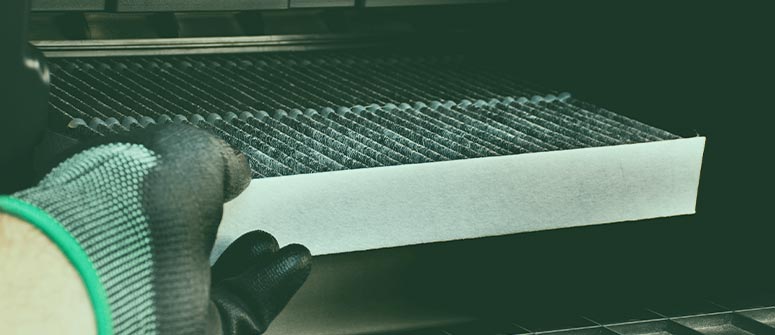
To reuse activated carbon, it has to be heated to 700°C and steamed. For the average home grower, this isn’t really an option.
Fortunately, charcoal is an organic and inert substance, and thus can be disposed of in normal waste without posing an environmental risk. But just be aware, the creation of activated charcoal does release CO₂.
Do you need a carbon filter to grow cannabis indoors?
If you have a small crop, a carbon filter might not be necessary. But the bigger a crop gets, the more pungent the smell becomes. So larger grows will probably benefit from them.
Also, if you live somewhere where growing cannabis is illegal, and you’re at risk of being caught, then a carbon filter is a sensible precaution.




